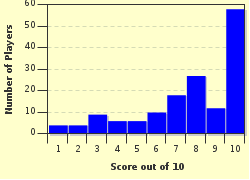Quiz Answer Key and Fun Facts
1. Which of these present-day animals did the great auk most closely resemble?
2. The great auk was called "geirfugl" by Norse sailors. To which part of the auk's body does this word refer?
3. Which famous Swedish naturalist included the great auk in his eighteenth century work entitled "Systema Naturae"?
4. What did great auks occasionally do during the cold winter months in the Northern Hemisphere?
5. Which one of these statements about great auks is true?
6. Great auks spent most of their lives at sea. However, why did they come ashore for two months every year?
7. In 1794, which northern city's officials passed a law banning the killing of great auks?
8. By 1830, museum curators in Europe realized that great auks were rapidly becoming extinct. What were these frantic directors particularly interested in obtaining?
9. Around 1850, the last living great auk was spotted on the Grand Banks of which Canadian province?
10. A stuffed great auk appears in the 1951 opera "The Rake's Progress." Which Russian composer, with the first name of Igor, composed this opera?
Source: Author
mrgrouchy
This quiz was reviewed by FunTrivia editor
crisw before going online.
Any errors found in FunTrivia content are routinely corrected through our feedback system.


